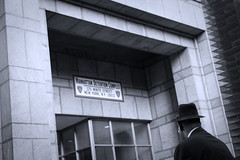South:
The Tombs
125 (block): Formally known as the
Manhattan Detention Complex, these buildings
connected by a pedestrian bridge are a jail for
those being arraigned or standing trial in the
nearby Criminal Court. It's a semi-modern successor
to the jail built in 1838 on a former island in
the Collect Pond, built in an Egyptianate style
that resembled a mausoleum, hence the nickname
inherited by the current complex.

The southern
building was built in 1941; the northern one,
replacing a torn- down section of the 1941
building, went up in 1990. The jail, which holds
about 900 short-term inmates, was dubbed the
Bernard B. Kerik Complex by Rudolph Giuliani in
2001, honoring the chauffeur whom Giuliani had
elevated, like Caligula's horse, to police commissioner; after Kerik's
many ethical failings came to light, the name
was removed by Mayor Bloomberg.

Among the notable criminals held here are
Bernard Goetz, Sid Vicious, Sean "Puffy" Combs,
"Preppy Murderer" Robert Chambers and the guy
who killed John Lennon.
Harlan Ellison was held here on a gun charge,
an experience that became the basis for his novel
Memos From Purgatory. Eric Cash is booked
here in the novel Lush Life.
Jim Carroll sings in "People Who Died" that "Bobby
hung himself from his cell in The Tombs." Denzel
Washington's release from prison in the film
American Gangster was shot here.
|